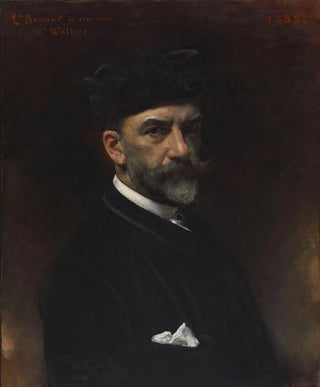Art print | Portrait of the Artist - Léon Bonnat


View from behind

Frame (optional)
Portrait of the Artist - Léon Bonnat – Captivating Introduction
In the vast panorama of art history, certain works stand out for their ability to capture the very essence of creativity. The "Portrait of the Artist" by Léon Bonnat is a striking example. This painting, resonating with emotional depth and technical finesse, invites the viewer to delve into the inner universe of the artist. Through this piece, Bonnat does not merely depict himself; he offers a mirror of his soul, where introspection and self-assertion intertwine. The art print of this masterpiece allows appreciation of the richness of its expression, while paying tribute to a creator whose impact on the art world remains invaluable.
Style and uniqueness of the work
Bonnat's work is characterized by an exceptional mastery of light and shadow, a technique inherited from the great masters of classical painting. In "Portrait of the Artist," each brushstroke seems to be a dialogue between light and form, revealing a psychological depth that transcends the simple portrait. The intense gaze of the artist, captured with remarkable precision, appears to invite us to explore his most intimate thoughts. The choice of colors, both rich and nuanced, also contributes to creating an atmosphere that is at once intimate and solemn. This painting, far from being a mere reflection of appearance, becomes an exploration of identity and creative passion, an indelible signature of Bonnat's style.
The artist and his influence
Léon Bonnat, born in 1833, is often regarded as one of the pillars of French academic painting. His artistic journey is marked by an relentless quest for perfection, both in technique and expression. Influenced by the masters of the past, Bonnat successfully integrated the lessons of the Renaissance while adapting them to his era. He also played a key role in training generations of artists, passing on his expertise through his classes at the École des beaux-arts. His influence extends far beyond his own work, inspiring artists who have drawn from his vision to develop their own artistic language. The "Portrait of the Artist" is thus not

Matte finish

View from behind

Frame (optional)
Portrait of the Artist - Léon Bonnat – Captivating Introduction
In the vast panorama of art history, certain works stand out for their ability to capture the very essence of creativity. The "Portrait of the Artist" by Léon Bonnat is a striking example. This painting, resonating with emotional depth and technical finesse, invites the viewer to delve into the inner universe of the artist. Through this piece, Bonnat does not merely depict himself; he offers a mirror of his soul, where introspection and self-assertion intertwine. The art print of this masterpiece allows appreciation of the richness of its expression, while paying tribute to a creator whose impact on the art world remains invaluable.
Style and uniqueness of the work
Bonnat's work is characterized by an exceptional mastery of light and shadow, a technique inherited from the great masters of classical painting. In "Portrait of the Artist," each brushstroke seems to be a dialogue between light and form, revealing a psychological depth that transcends the simple portrait. The intense gaze of the artist, captured with remarkable precision, appears to invite us to explore his most intimate thoughts. The choice of colors, both rich and nuanced, also contributes to creating an atmosphere that is at once intimate and solemn. This painting, far from being a mere reflection of appearance, becomes an exploration of identity and creative passion, an indelible signature of Bonnat's style.
The artist and his influence
Léon Bonnat, born in 1833, is often regarded as one of the pillars of French academic painting. His artistic journey is marked by an relentless quest for perfection, both in technique and expression. Influenced by the masters of the past, Bonnat successfully integrated the lessons of the Renaissance while adapting them to his era. He also played a key role in training generations of artists, passing on his expertise through his classes at the École des beaux-arts. His influence extends far beyond his own work, inspiring artists who have drawn from his vision to develop their own artistic language. The "Portrait of the Artist" is thus not






